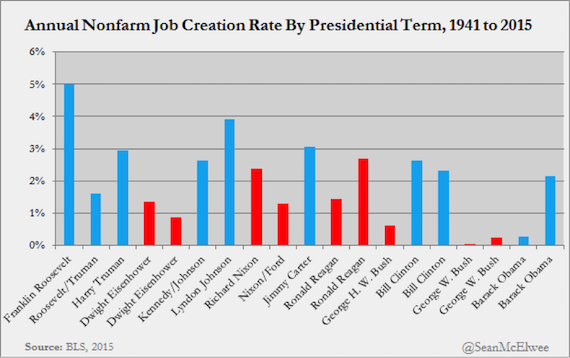Consider the following fact: The last time a Republican president created an average of 1 million jobs a year over the course of his presidency was nearly three decades ago, under Ronald Reagan. When the the 2016 election comes around, a full 44 percent of voters will have entered the workforceafter that period of time. Then consider that Barack Obama has created 7.35 million jobs since taking office, and will almost certainly cross the million-per-year threshold. And that, for many Americans, the last time the economy was working for them was under Bill Clinton.
As the chart below (using data from the Economic Policy Institute) shows, the last time Americans at the bottom of the income distribution had a raise was during the sustained employment growth under Bill Clinton.
The conclusion? If Democrats want to win the White House, they need to promote a progressive, pro-jobs agenda.
I’ve previously discussed the rather large body of research suggesting that not only does the economy perform better under Democrats, it tends toperform better for everyone under Democrats. People of color do far better in terms of employment, incarceration and income growth when a Democrat is in office. The incomes of the poorest tend to increase more rapidly as well. Both effects are likely tied to two major policies: First, Democrats tend to preside over lower unemployment rates; and, second, they are far more likely to raise the minimum wage. There are other factors at work, of course: I’ve noted how market conditioning (things like regulatory policy) can change outcomes as well. But another major factor is that the key to increasing the bargaining power of workers and creating a more racially just society is jobs. And progressive policy creates jobs.
There are several specific factors that explain this.
(1) Liberal governments tend to invest more money in infrastructure and education, both of which bolster growth.
(2) While conservative governments try to maximize growth for the rich by reining in inflation, progressives benefit everyone by reducing unemployment.
(3) Conservatives spend a large amount of their political capital reducing labor force participation among gays, people of color and women. Conservatives oppose policies that would help women balance work and family responsibilities, openly sabotage their economies to discriminate against gays, and pursue policies that overwhelmingly harm people of color. By doing this, conservative governments shut out talent and competition, in all probability harming economic growth: One study finds that about one-fifth of the increase in productivity growth between 1960 and 2008 can be explained by the increase in talent from women and people of color getting jobs they were previously excluded from.
(4) Conservatives pursue policies that increase inequality, which studies suggest can also slow growth.
(5) Conservatives are less queasy about the influence of money on politics, fostering cronyism that can undermine growth.
(6) A weak safety net means that fewer Americans can take entrepreneurial risk, when entrepreneurship is a key factor in bolstering growth.
(7) By creating a winner-take-all economy, conservative governance reduces social trust necessary for growth.
(8) By promoting war and violence abroad, and a bloated military at home, conservative governments reduce the money available for clean energy, healthcare, education and tax cuts for the middle class, which create more jobs. Matt Yglesias also argues it could increase oil shocks, thereby harming growth.
(9) By promoting an oversized and unregulated financial system, conservative governments make crisis more likely. Studies also suggest that when the financial sector gets too large it starts to reduce growth.
(10) By reducing upward mobility, conservative governments reduce growth by leaving millions of opportunity-less youth mired in poverty.
(11) Conservatives are less amenable to more open immigration policies, when immigration boosts growth.
Whichever of these factors cause conservative governments to be less effective, the differences are stark. The chart below shows the average job growth under each president over the last 75 years.
Bloomberg examined private sector job growth between January 1961 and April 2012. Over that period, Republicans have held the Presidency for 28 years and Democrats for 23. Republican presidents created 71,000 jobs per month, while Democratic presidents created 150,000. In total, Democrats created 42 million jobs, compared to Republicans 24 million.
All of this means that Hillary Clinton should embrace jobs and argue that progressive policies can unleash economic growth. She should argue that the country needs a proactive government working with the free market to best promote the interests of all Americans, not just the rich. As Bob Moser notes in the American Prospect, the most successful Democratic candidates have been those who embraced economic populism rather than a fuzzy centrism. He points to Gary Peters, the only freshman Democratic Senator, who ran a populist campaign that targeted the Kochs for their plutocratic policies. Moser notes that three of unabashed populist progressives — Jeanne Shaheen, Jeff Merkley and Al Franken — not only won their elections but also won white working class voters at a time when Democrats nationally lost them by 30 percentage points. (Peters lost the white working class, but only 47 percent to 48 percent.)
Dorian Warren is an associate professor at Columbia and a Fellow at the Roosevelt Institute who is leading “Putting Families First: Good Jobs for All,” which seeks to put jobs at the center of the political agenda. He tells Salon via e-mail that a jobs-centered Presidential campaign could be a political winner: “It is time to embrace a simple but achievable idea: that government should take action to create millions of good, new jobs in emerging sectors and ensure these jobs are open and accessible to all, guarantee decent wages and benefits for all who want to work, and ensure equity in the labor market for women and people of color.”
Warren cites research by Celinda Lake showing that three core messages resonate with Americans across the political spectrum: infrastructure spending, government investment in green energy and government creating jobs in high unemployment communities, particularly communities of color. As the chart below shows, progressive policies are popular with the Rising American Electorate (African Americans, Hispanics, millennials, and unmarried women) who veteran pollster Stanley Greenberg notes will be more than half of the electorate in 2016.
The Lake memo also notes that turnout is key to a progressive victory. In 2014, 34.5 percent of the Rising American Electorate who voted Obama for Obama’s re-election in 2012 stayed home. Mobilizing these voters will be key.
If Clinton is the nominee, she should emphasize the track record of Democrats creating and sustaining jobs. Instead of running away from Obama’s achievements should build on them. She should focus her message on a strong public sector being necessary for a strong private sector. By setting the rules for fair play, the government ensures that those who get ahead do so by creating value, rather than extracting it. By investing in the next generation, government gives private companies an educated and highly trained workforce. By ensuring paid sick leave, childcare and universal pre-k, the government allows women to bring their skills to creating prosperity. The difference between conservative and progressive governance is simple: one benefits a small elite while the other promotes widespread prosperity.




